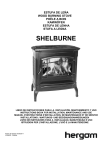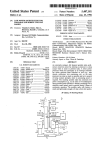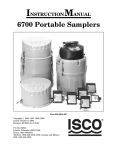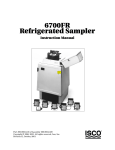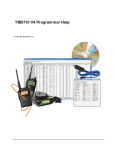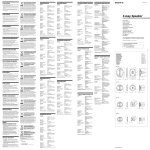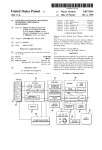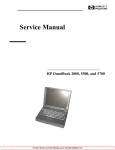Download Remote squelch detect for use with a radio receiver
Transcript
United States Patent [191 [11] [45] Rozanski, Jr. [54] MOBILE RADIO COMMUNICATIONS 4,748,685 Patent Number: Date of Patent: May 31, 1988 Primary Examiner-Robert Lev SYSTEM Attorney, Agent, or Firm-Steven G. Parmelee [75] Inventor: Walter J. Rozansld, Jr., Hurst, Tex. [73] Assignee: Motorola, Inc., Schaumburg, Ill. [21] Appl. No.: 917,923 [22] Filed: Oct. 10, 1986 [57] ABSTRACT A vehicle mounted mobile transceiver (11) communi cates via a secondary mobile unit (51) with a short range portable unit (10). The portable unit (10) can be either a cordless microphone or a transceiver. The portable unit [51] Int. Cl.4 ............................................. .. H01B 1/16 (10) allows a remotely positioned operator to transmit [52] U.S. Cl. . . . . . messages to a base station (13). To ensure security and [58] Field of Search .................... .. 379/63, 68; 455/‘33, . . . . . . . .. 455/218; 379/63 455/218, 35, 221, 212; 381/94 [56] References Cited U.S. PATENT DOCUMENTS 3,092,772 6/ 1963 3,614,321 3/1969 3,921,074 11/1975 Dalton et a1. ..................... .. 455/221 Shaw et al. .... .. 455/221 Baird ...... .. 455/221 4,359,780 1 1/ 1982 Day .... .. 4,479,250 10/1984 Flood 455/ 222 . ... ... . . . . . .. 455/ 213 4,525,867 6/1985 Shiratani ................... .. 455/ 194 4,541,118 9/1985 Eastmond et a1. ....... .. 455/35 4,600,922 7/1986 Dunkerton et a1. .. .. 340/825.44 4,627,101 12/1986 Anderson et a1. ................ .. 455/194 OTHER PUBLICATIONS Motorola Service Manual 58P8l0l0C09A, “PAC-RT”, Portable/Mobile Vehicular Repeater System. reliable operation, the portable and vehicle mounted units use digitized codes for ID and instruction pur poses. These codes are newly generated from time to time by the vehicle mounted unit and are imparted to the portable unit via a battery charging interface. An improved remote squelch detect is also provided. The improved remote squelch detect substitutes the normal input to the vehicle primary mounted mobile trans ceiver (11) squelch gate for an audio signal. The remote squelch detect can then detect the presence or absence of this input signal at the output of the audio PA for the vehicle mounted mobile transceiver, and this detection can be used to enable the secondary mobile unit to repeat the incoming message to the portable unit. With less delay than the prior art methods. 4 Claims, 16 Drawing Sheets 121 132 [122 f PRESELECTOR rue-1&7 x 'F I129 131 FlLTER/LlMlTER DISCRIMlNATOR X . 124 FIRST LOCAL OSCILLATOR VOICE 133 DATA 12a SECOND LOCAL OSCILLATOR AUDIO PROCESSING “f OUTPUT DATA mocsssmc T°13aoun=ur E US. Patent May 31,1988 Sheet 3 0f 16 4,748,685 EMERGENCY 22 FIG.4 21 27 27 28 29 FIG.6‘ 31 , US. Patent May 31,1988 Sheet 4 of 16 4,748,685 FROM SECONDARY MOBILE UNIT BATTERY CHARGING UNIT / \ DATA TRICKLE RESET CHARGE 302 BATTERY CHARGING UNIT B01 r. _ _ _ DATA RESET I WATCH ooc_‘<— - — TIMER k...‘ PORTABLE uNn — — — ._ L 799 - —>r-ALARM_. MICROPROCESSOR L......] 304 109 VOICE TRANSMITTER I l LEATA_I___ J | 802 ________.1RECEIVERI FIG.'7 —— US. Patent S f 16 mop W R: E5M2 . weme #ww 20-6 omEziowa man, M mR19n?N8 H<my RN. 5. ZAQEB E \\v,» ,MQ5KBHEQUEBLE No’ Pop 5 4,748,685 US. Patent May 31,1988 1 :L_=;_ J iim5|HE 2012 |_ _ Sheet 6 of 16 F9AIG. 8 I "' L J-lj I =17-1r | 116 I 177'? ‘6163172 166r_153 168' 103 I 17‘-»164 5r.l \ 167 162 asif 152 154161157 159% i.Q It@151 —+ 102 4,748,685 US. Patent May 31,1988 Sheet 8 of 16 4,748,685 US. Patent May 31,1988 Sheet 9 of 16 4,748,685 T0 AU I l CONTROL I’ 701 INPUT SECONDARY MOBIL TRANSCE Y~—» >i I 1 1 _'_ |/—— ‘ 702 DISCRIMINATOR '‘ I I 707 732 l_ _ '_" I ‘ 714 ‘ [ 711 I ‘A o 706 ‘ SQUELCH / GATE <—-——--———a/L 713 704 708 L _ -- -—0 )1 705 \} CONTROL HEAD AUFQ'O PRIMARY MOBILE UNIT Au 5V SIG SOURCE 709 718 712 726 7:0 SPEAKER 727 m ‘ 731 + 728 ' '1" 729 v °—-> TRANSMIT FIG. 1 0 REF ENABLE US. Patent May 31,1988 Sheet 10 of 16 4,748,685 [126 I 4 [124 @41 % 43__l9 L. _ in? _ 1FI2GA- US. Patent May 31,1988 Sheet 11 of 16 4,748,685 US. Patent May 31,1988 Sheet 12 of 16 4,748,685 1601 \I_ _ __ __ _| I 601 I ~" 602 I I 601 L“_-'__J FIG. 1 3 FIG. 14 US. Patent May 31,1988 Sheet 13 of 16 4,748,685 CODE GENERATION F 1t ' I 1 D01 PORTABLE INTERCONNECTION SENSED GENERATE NEW CODE 1 1002 TRANSMIT NEW CODE r1005 PORTABLE DECO1DES AND BUFFERS NEW CODE 1006 CODE PORTABLE TRANSFER CONNECTED COMIZLETE NO 1007 1 USE OLD CODE 11003 NEW CODE ACCEPTED ‘ 1 100a TRICKLE CHARGE CONTINUES 1011 VERIHEQNBT‘JBIETJRSEINEDWS CODE FI G. 1 I 1006 US. Patent May 31,1988 Sheet 14 of 16 4,748,685 [ID14 MOBILE CONFIRMS NEW CODE 1101s ' 1 1.105111 SENDS BAD CODE SIGNAL MOBILE AND PORTABLE I USE NEW CODE PORTABLE UNIT OPERATION I FI G. 1 '7 [1101 MICROPROCESSOR OFF MICRO . PROCESSOR sTRgBED f11os TRANSMIT PTT CODE FOR 2 SECONDS EMERGENCY 1103 1107 PTT STILL YEs CLO?SED N [1104 TRANSMIT EMERGENCY CODE FOR 10 SECONDS r ’ CONTINUE SENDING PTT CODE I I [1107 ‘ CONCLUDE TRANSMISSION I I US. Patent May 31,1988 INCREMENT COUNT 1 Sheet 15 0f 16 4,748,685 901 YES I 903 TRANSMIT RANGE BURST I904 CLEAR COUNT 1 FIG. 18 MESSAGE FLAG SET ? f 903 N0 INCREMENT COUNT 2 914 PORTABLE ACKNOWLEDGE RECEIVED YES I911 NO +1912 +Jf913 CLEAR MESSAGE FLAG CLEAR COUNT 2 TERMINATE MISSED MESSAGE SIGNAL 1 ' , TRANSMIT MISSED MESSAGE SIGNAL ‘ US. Patent May 31,1988 Sheet 16 0f 16 4,748,685 I 922 INCREMENT COUNT 1 I CLEAR OUT OF RANGE FLAG [927 CLEAR COUNT 1 H 7 I924 ] SET OUT OF RANGE FLAG l 0-——( I 929 931 MISSED MESSAGE SIGNAL lgETECTED I933 ALARM 1 FIG. 19 1 4,748,685 MOBILE RADIO COMMUNICATIONS SYSTEM TECHNICAL FIELD This invention relates generally to RF communica tions systems, and particularly to mobile radio systems. The invention also relates to portable radios that may be used with such a mobile radio system. BACKGROUND ART RF communications systems are well known in the art. In many such systems, as in public safety applica tions, vehicles are equipped with mobile transceivers that allow public safety of?cers to communicate with 2 to be manufactured and operated in a relatively inex pensive manner. In a transmit only con?guration, the portable unit essentially operates as a cordless micro phone. If desired, a public address system can be pro vided on the vehicle to allow return messages to be audibly broadcast to the portable user. In a transceiver con?guration, of course, return messages could be re turned directly to the portable unit via a two-way link with the secondary mobile unit. The portable unit includes a battery to support its portable function. To reduce maintenance and enhance reliability, the battery can be regularly recharged. The secondary mobile unit can have a battery charging cir one or more base stations and also with other similarly 15 cuit that functions to recharge the portable unit battery equipped vehicles in the system. Such a mobile based whenever the portable unit is connected thereto. system typically includes a vehicle mounted trans To ensure that the secondary mobile unit and the ceiver, a microphone, a control head, and an antenna. In portable unit recognize the legitimacy of each other’s addition, a base station communicates with the vehicle communications, subaudible digital codes are transmit mounted equipment and typically serves as a message 20 ted therebetween as necessary. To minimize mainte dispatch center. As the situation may require, repeaters may be provided to extend the effective range between nance, these codes are freshly generated and exchanged each time the portable unit and the secondary mobile the mobile and base station, all as well understood in the unit are physically joined. In one embodiment, these art. The above con?guration works well, so long as the 25 codes are generated by the secondary mobile unit and transmitted to the portable unit via the battery charger public safety of?cer (or other individual) remains in the circuit. In another embodiment, the battery charger vehicle. Once the of?cer moves beyond the operational circuit can be controlled to allow a microprocessor in range of the microphone, however, the of?cer typically the secondary mobile unit to reset a microprocessor on loses the ability to forward communications to the base station. Since the range of the microphone will usually 30 board the portable unit. When both the portable unit be governed by the length of the microphone cord, and and the secondary mobile unit are transceivers, the since this cord must usually be relatively short, commu possibility exists that the portable unit may move out of nications remote from the vehicle are usually rendered range of the secondary mobile unit, and that an incom dif?cult if not impossible. ing message may be missed or that an outgoing message To meet this problem, portable transceivers can be 35 may be prevented. To resolve this, in one embodiment used to allow the of?cer to be able to communicate with the secondary mobile unit occassionally broadcasts a the base station when separated from the vehicle. The range burst signal. If the portable unit does not receive portable transceiver must, in order to be effective, emu such a range burst signal with a predetermined period of late the vehicle mounted system in all relevant aspects, time, an out of range alarm can be provided by the including frequency capabilities, power rating, and sig portable unit to the user. nalling capabilities. In effect, a public safety service that In another embodiment, the portable unit can be con implements this system must provide two wholly and independently functioning radio systems for each of its vehicles. Though this adequately supports the desired ?gured to provide an acknowledge signal upon receiv ing a message from the secondary mobile unit. If the communication function, this solution also represents a 45 secondary mobile unit does not receive such an ac relatively costly approach. knowledgement, it will broadcast a missed message There therefore exists a need to provide relatively signal. When the portable unit moves back within inexpensive, effective, and reliable communications for range, it will receive the missed message signal and public safety of?cers and others who ordinarily make provide a missed message alert to the user. The user can use of a vehicle mounted transceiver but who must also 50 then take appropriate action to ascertain the contents of carry out operations away from the vehicle from time the message. to time. SUMMARY OF THE INVENTION These needs and others are substantially met through provision of the improved mobile radio communica— In yet another embodiment, the squelch gate for the primary vehicle mounted mobile transceiver can be monitored, in a non-invasive way, to allow appropriate enabling of the secondary mobile unit when transmit ting messages received by the primary vehicle mounted tions system disclosed herein. This system makes use of mobile transceiver from the portable transceiver unit. a relatively short range portable transmitter (or trans To facilitate this, a predetermined audio signal can be ceiver, as the case may be) that directly communicates with a secondary mobile unit. The secondary mobile 60 routed through the squelch gate in the primary mobile, and the output to the speaker for the primary mobile unit in turn communicates with the primary vehicle can then be monitored for presence of this predeter mounted mobile transceiver. The secondary mobile unit mined audio signal. When receiving a viable signal, the functions to ensure the propriety of communicating with the portable unit, and then acts in concert with the . squelch gate for the primary mobile will be closed, and primary mobile unit like a repeater to allow communi 65 hence the predetermined audio signal can be detected. cation between the portable and the base station. When detected, the transmit function for the secondary The short range needs of the portable unit minimize mobile unit can be enabled to allow transmission of the power requirements, and in part allow the portable unit signal being received by the primary mobile. 3 4,748,685 4 MHz, 171.045 MHz, 171.105 MHz, 171.845 MHz, or BRIEF DESCRIPTION OF THE DRAWINGS 171.905 MHz). The maximum output power cannot exceed 50 milliwatts, and the maximum emission band These and other attributes of the invention will be width cannot exceed 54 kHz. It should be noted that come more clear upon making a thorough and complete study and review of the following description of the 5 these particular frequencies may give rise to data recep tion problems, since adjacent frequencies can be used best mode for carrying out the invention, particularly for hydrological and meteorological data transmissions when reviewed in conjunction with the drawings, as used by the power, petroleum, forest products, busi wherein: ness, and railroad radio services. Therefore, care must FIG. 1 comprises a block diagram depiction of the invention; 10 be taken to ensure that the portable unit (10) will not only meet the above noted speci?cations, but that the FIG. 2 comprises a block diagram depiction of the system will also remain relatively immune to interfer invention; ence problems from adjacent channels. FIG. 3 comprises a block diagram depiction of the Referring now to FIG. 3, the secondary mobile unit interface between the secondary mobile unit and the vehicle’s communication system; 15 (51) that interfaces between the portable unit (10) and the primary mobile unit (11) essentially comprises a FIG. 4 comprises a perspective view of the portable radio receiver (or transceiver when used with a porta unit; FIG. 5 comprises a bottom plan view of the portable _ ble transceiver as explained below in more detail). In unit; practice, the secondary mobile unit (51) can be FIG. 15 comprises a schematic diagram of the battery charging and interface circuit; an emergency code, to be broadcast to the base station FIG. 6 comprises a detailed perspective view of the 20 mounted, for example, inside the housing or another radio interface product such as a Systems 90 module battery charging hub; (52) (model number HLN106) as manufactured by Mo FIG. 7 comprises a block diagram depiction of the torola, Inc. The Systems 90 module (52) connects be portable unit; tween the primary mobile unit microphone (53) and the FIG. 8 comprises a block diagram depiction of a 25 primary mobile unit (11) via the microphone input port. transmitter suitable for use in the invention; The systems 90 module (52) adds two primary fea FIGS. 9(a)-9(c) comprise a schematic diagram of the tures to a mobile system. First, the Systems 90 module transmitter; (52) causes the primary mobile unit (11) to broadcast a FIG. 10 comprises a schematic depiction of the trans subaudible digital signal comprising a unique ID code mit enable feature of the invention; FIG. 11 comprises a block diagram depiction of a 30 every time the operator closes the push-to-talk (PTT) switch on the microphone (53). In this way, a base receiver suitable for use in the invention; station (13) equipped to decode the ID code can iden FIGS. 12(a) and 12(b) comprise a schematic diagram tify the mobile it is communicating with, and maintain a of the receiver; record of such proceedings. Second, the Systems 90 FIG. 13 comprises a schematic diagram of interface switches for use in the secondary mobile unit; 35 module (52) can detect switching of an emergency switch (50). When switching is sensed, the Systems 90 FIG. 14 comprises a schematic diagram of a watch module (52) will cause the ID code for the mobile, plus 7 dog circuit; FIGS. 16(a) and 16(b) comprise a ?ow chart of the new code generation and transfer process; FIG. 17 comprises a flow chart of portable unit oper ation under certain operating circumstances; FIG. 18 comprises a flow chart of secondary mobile unit operation under certain operating circumstances; and FIG. 19 comprises a ?ow chart of portable unit oper ation under certain operating circumstances. (13) for at least a predetermined period of time, or until the base station (13) acknowledges receipt of the signal. In this way, an operator can press the emergency switch (50), and the primary mobile unit (11) will broadcast this call for help to the base station (13) regardless of what else the operator may do. As will be shown below, 45 the secondary mobile unit (51) can interface with such a module (52) and thereby allow the portable unit (10) to have bene?t of such features as well. Referring now to FIG. 4, the secondary mobile unit can be seen as generally depicted by the numeral 51 and 50 as con?gured in conjunction with a Systems 90 module BEST MODE FOR CARRYING OUT THE INVENTION (52). The secondary mobile unit (51) includes generally an antenna (54) (which may be comprised of the micro Referring now to the drawings, and in particular to phone cord (54) for the primary mobile unit (11)), a FIG. 2, the invention can be seen to comprise a portable receiver (120), a secondary mobile unit microprocessor unit transmitter (10) (or transceiver, as the case may be, and as explained in more detail below) that communi- 55 (1701), a battery charging unit (1731), and a watchdog cates with a secondary mobile unit (51) that mounts in a timer (1732). As will be described below in more detail, the re vehicle (12). The secondary mobile unit (51) connects to ceiver (120) receives both voice and data signals from a primary mobile unit (11) that in turn communicates the portable unit (10) and then functions to separate with a base station (13). In effect, the primary and sec ondary mobile units (11 and 51) function as a repeater to 60 these signals to thereby provide the voice signal (702) directly to the Systems 90 module (52) where it can connect the portable unit (10) to the base station (13). serve as the audio input to the primary mobile unit (11). In an application where the portable unit (10) in The data signals (1703) from the portable unit (10) are cludes only a transmitter and effectively comprises a provided to the secondary mobile unit microprocessor cordless microphone, the portable unit (10) must meet certain FCC requirements governing operation of such 65 (1701) (provided, for example, through use of an a device in the United States. For example, the portable unit (10) can only transmit on one of eight frequencies (169.445 MHZ, b 169.505 MHz, 170.245 MHZ, 170.305 MC146805F2 as manufactured by Motorola, Inc.). The microprocessor (701) functions to decode and act upon the incoming data signals and will function 5 4,748,685 6 either to enable a PTT switch in the Systems 90 module (51) to transmit data to the portable unit microprocessor (52) by providing an enable PTT signal (1704) or to enable transmission of an emergency signal via the Sys tems 90 module (52) through provision of an enable (801), as described below in more detail. In an alternative embodiment, the portable unit (10) can be con?gured as a transceiver having a receiver emergency signal (1706). The microprocessor (1701) (120) that receives signals transmitted by the secondary can also provide encoded data and reset signals as de mobile unit (51) and that demodulates these received scribed below to the battery charging unit (1731) for use in providing new communication codes to the portable unit (10). Finally, the watchdog timer (1732) may be utilized to assure regular proper operation of the microprocessor sor (801) and voice signals to an appropriate audio transducer system (802). In another embodiment, the portable unit (10) can include additional buttons in the input unit (303) as signals to provide data to the portable unit microproces (1701) in accordance with well understood prior art desired to facilitate remote control of other desired functions, such as a public address system on board the vehicle, ?ashing lights on the vehicle, sirens on the vehicle, and the like. technique. Referring now to FIG. 5, the portable unit (10) can be housed in a small plastic housing (21) having a belt clip (22) to allow easy mounting of the portable unit (10) on the person of the operator. The portable unit (10) also includes a PTT button (23), an emergency button (24), and a microphone (26). A loop antenna, such as those Referring now to FIG. 9, a block diagram depiction of a transmitter suitable for use in the portable unit (10) (or in the secondary mobile unit (51) when the latter is con?gured as a transceiver) can be seen as generally used in personal pagers, can be concealed on the inside 20 depicted by the numeral 100. The transmitter (100) includes generally a microphone (101), a ?rst ampli?er of the housing (21). (102), a limiter/deviation adjustment unit (103), a sum mation node (104), a frequency modulatable oscillator (106), a second ampli?er (107), a ?lter (108), and an antenna (109). The ?rst ampli?er (102) serves to amplify In addition, and with reference to FIG. 6, two battery charging ports (27) can be provided through the hous ing (21) to allow access to a battery (and other circuitry described below). To complement the charging ports (27), a battery charging HUB (28) (FIG. 7) can be pro vided having a cavity (29) formed therein for receiving the portable unit (10) and having appropriate conduc audio signals provided by the microphone (101), which ampli?ed signals are then passed to the limiter/devia tion adjustment unit (103) to properly prepare the audio signal for modulation and subsequent transmission. The processed audio signal is then summed with data signals from the relevant microprocessor at the summation node (104) and utilized to modulate the oscillator (106). The modulated carrier signal then passes through the second ampli?er (107) and output ?lter (108) to the antenna (109) that broadcasts the signal. tors (31) disposed therein that mate with the charging ports (27) of the portable unit (10). The battery charging HUB (28) can be operably con?gured in conjunction with the secondary mobile unit (51) as described below in more detail. Referring now to FIG. 8, the portable unit can be seen as depicted generally by the numeral 10. The por table unit (10) includes generally a portable unit micro Referring now to FIGS. l0a-10c, a more detailed description of the transmitter (100) will be described. The microphone (101) can be provided through use processor (801), an input unit (303), a battery charging unit (302), a transmit enable unit (304), a transmitter (100), a microphone (101), and an antenna (109). of a crystal microphone such as an MK 1301 (when using the transmitter (100) with the secondary mobile The portable unit microprocessor (801) receives input unit (51), one would of course substitute an appropriate signals from the input unit (303) as operated by the operator. The input unit (303) comprises the PTT but audio signal coupling mechanism to allow input of the primary mobile unit (11) audio signal output). The out ton (23) and the emergency button (24) referred to put of the microphone (101) connects to an ampli?er stage (102), essentially comprised of a buffer section and switches by causing the transmit enable unit (304) to an ampli?cation section. The buffer section includes a enable the transmitter (100). In the ordinary operating 9642 transistor (151) having its emitter connected to mode, the microprocessor can literally be turned off in ground and its collector connected through a 5.1 k ohm order to minimize current drain and extend battery life. resistor (152) to a switched voltage source (153) and When the operator pushes either button, related cir also through a 100 k ohm resistor (154) to the base cuitry activates the microprocessor and strokes an inter thereof. The base of this transistor (151) also connects to rupt to cause the microprocessor to determine which ground through a 100 k ohm resistor (156), and through button was pushed and to react accordingly. If the PTT a 0.02 microfarad capacitor (157) to the output of the button has been pushed, an appropriate PTT code is microphone (101). In addition, the output of the micro transmitted subaudibly by the portable to the mobile for 55 phone (101) connects to a 2.2 k ohm biasing resistor a predetermined period of time, such as two seconds. (158) and an appropriate grounded ?lter capacitor This allows the mobile to identify the portable (this (159). above. The microprocessor (801) responds to these normally requires around 642 milliseconds), and for the The collector of the transistor (151) connects through‘ base station to decode and acknowledge the mobile. If a 2 microfarad coupling capacitor (161) to a voltage the PTI‘ button remained closed beyond the two sec 60 divider comprised of a 47 k ohm resistor (162) and an 11 onds, the portable continues to send the PTT code. k ohm resistor (163), and also to the base of a 9648 Otherwise, a termination of message signal may be sent. transistor (164). The emitter of this transistor (164) con The battery charging unit (302) allows a battery (not nects to a 91 ohm resistor (166). The collector of this shown) to be charged when the portable unit (10) is in transistor (164) connects to a 3.3 k ohm biasing resistor the battery charging hub (28) described above. The battery charging unit (302) also allows the portable unit microprocessor (801) to be reset by the secondary mo bile unit (51) and to allow the secondary mobile unit 65 (167), and through a 0.1 microfarad coupling capacitor (168) to the limiter/deviation adjustment stage (103). The limiter/deviation adjustment state (103) includes two grounded parallel con?gured back-to-back diodes



























